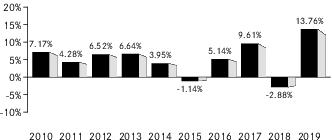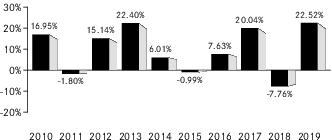up to an including $24.0 billion, plus 0.5145% per annum of the aggregate net assets over $24.0 billion, up to and including $30.0 billion, plus 0.4888% per annum of the aggregate net assets in excess of $30.0 billion.
As of July 1, 2020, for its investment advisory services to the iShares Expanded Tech Sector ETF, iShares Expanded Tech-Software Sector ETF, iShares Global Consumer Staples ETF, iShares Global Energy ETF, iShares Global Financials ETF, iShares Global Healthcare ETF, iShares Global Industrials ETF, iShares Global Infrastructure ETF, iShares Global Materials ETF, iShares Global Tech ETF, iShares Global Timber & Forestry ETF, iShares Global Utilities ETF, iShares North American Natural Resources ETF, iShares North American Tech-Multimedia Networking ETF and iShares Semiconductor ETF, BFA was paid a management fee from each Fund corresponding to the Fund’s allocable portion of an aggregate management fee calculated based on the aggregate average daily net assets of the following iShares funds: iShares Expanded Tech Sector ETF, iShares Expanded Tech-Software Sector ETF, iShares Global Clean Energy ETF, iShares Global Comm Services ETF, iShares Global Consumer Discretionary ETF, iShares Global Consumer Staples ETF, iShares Global Energy ETF, iShares Global Financials ETF, iShares Global Healthcare ETF, iShares Global Industrials ETF, iShares Global Infrastructure ETF, iShares Global Materials ETF, iShares Global Tech ETF, iShares Global Timber & Forestry ETF, iShares Global Utilities ETF, iShares North American Natural Resources ETF, iShares North American Tech-Multimedia Networking ETF and iShares Semiconductor ETF. The aggregate management fee is calculated as follows: 0.48% per annum of the aggregate net assets less than or equal to $10.0 billion, plus 0.43% per annum of the aggregate net assets over $10.0 billion, up to and including $20.0 billion, plus 0.38% per annum of the aggregate net assets over $20.0 billion, up to and including $30.0 billion, plus 0.342% per annum of the aggregate net assets in excess of $30.0 billion.
Prior to July 14, 2021 and for the fiscal year ended March 31, 2021, for its investment advisory services to the iShares Expanded Tech Sector ETF, iShares Expanded Tech-Software Sector ETF, iShares Global Consumer Staples ETF, iShares Global Energy ETF, iShares Global Financials ETF, iShares Global Industrials ETF, iShares Global Infrastructure ETF, iShares Global Utilities ETF, iShares North American Natural Resources ETF, iShares North American Tech-Multimedia Networking ETF and iShares Semiconductor ETF, BFA was paid a management fee from the Fund corresponding to the Fund’s allocable portion of an aggregate management fee calculated based on the aggregate average daily net assets of the following iShares funds: iShares Expanded Tech Sector ETF, iShares Expanded Tech-Software Sector ETF, iShares Global Clean Energy ETF, iShares Global Comm Services ETF, iShares Global Consumer Discretionary ETF, iShares Global Consumer Staples ETF, iShares Global Energy ETF, iShares Global Financials ETF, iShares Global Healthcare ETF, iShares Global Industrials ETF, iShares Global Infrastructure ETF, iShares Global Materials ETF, iShares Global Tech ETF, iShares Global Timber & Forestry ETF, iShares Global Utilities ETF, iShares North American Natural Resources ETF, iShares North American Tech-Multimedia Networking ETF and iShares Semiconductor ETF. The aggregate management fee is calculated as follows: 0.48% per annum of the aggregate net assets less than or equal to $10.0 billion, plus 0.43% per annum of the aggregate net assets over $10.0 billion, up to and including $20.0 billion, plus 0.38% per annum of the aggregate net assets over $20.0 billion, up to and including $30.0 billion, plus 0.342% per annum of the aggregate net assets in excess of $30.0 billion.
Effective July 14, 2021, for its investment advisory services to the iShares Expanded Tech Sector ETF, iShares Expanded Tech-Software Sector ETF, iShares Global Consumer Staples ETF, iShares Global Energy ETF, iShares Global Financials ETF, iShares Global Industrials ETF, iShares Global Infrastructure ETF, iShares Global Utilities ETF, iShares North American Natural Resources ETF, iShares North American Tech-Multimedia Networking ETF and iShares Semiconductor ETF, BFA is paid a management fee from the Fund corresponding to the Fund's allocable portion of an aggregate management fee calculated based on the aggregate average daily net assets of the following iShares funds: iShares Expanded Tech Sector ETF, iShares Expanded Tech-Software Sector ETF, iShares Global Clean Energy ETF, iShares Global Comm Services ETF, iShares Global Consumer Discretionary ETF, iShares Global Consumer Staples ETF, iShares Global Energy ETF, iShares Global Financials ETF, iShares Global Healthcare ETF, iShares Global Industrials ETF, iShares Global Infrastructure ETF, iShares Global Materials ETF, iShares Global Tech ETF, iShares Global Timber & Forestry ETF, iShares Global Utilities ETF, iShares North American Natural Resources ETF, iShares North American Tech-Multimedia Networking ETF and iShares Semiconductor ETF. The aggregate management fee is calculated as follows: 0.4800% per annum of the aggregate net assets less than or equal to $10.0 billion, plus 0.4300% per annum of the aggregate net assets over $10.0 billion, up to and including $20.0 billion, plus 0.3800% per annum of the aggregate net assets over $20.0 billion, up to and including $30.0 billion, plus 0.3420% per annum of the aggregate net assets over $30.0 billion, up to and including $40.0 billion, plus 0.3078% per annum of the aggregate net assets in excess of $40.0 billion.
Prior to July 14, 2021 and for the fiscal year ended March 31, 2021, for its investment advisory services to the iShares Preferred and Income Securities ETF, iShares Russell 2000 ETF, iShares Russell 2000 Growth ETF and iShares Russell 2000 Value ETF, BFA was paid a management fee from each Fund calculated based on the aggregate average daily net assets of the following






















